Niue Island 2 Dollar Silver Coin 2010 Lilies of the Valley - Faberge Egg
Series: Imperial Fabergé Eggs
Imperial Fabergé Eggs, known also as Tsar’s Fabergé Eggs, are considered masterpieces of the jeweller’s art and a symbol of extravagance and luxury. Created by Peter Carl Fabergé and his assistants for tsars: Alexander III and Nicholas II of Russia, the eggs were made of gold and silver and decorated with enamels and precious stones.
The Mint of Poland released a series of collector coins dedicated to these extraordinary pieces of art. The first coin from the series was “Coronation Egg”, the next is “Lily of the Valley Egg”.
The coin depicts precisely an image of the Lily of the Valley Egg. Very low mintage and unusual shape crystals make the coin highly attractive for collectors
Obverse: At the bottom – open Spring Flowers Egg (1899-1903) with a miniature basket of wood anemones inside. Above – Niue Island’s Coat of Arms with the inscription “Elizabeth II” below. Around the head – decorative neorococo scroll ornament. At the top – issuer’s name: Niue Island. On the right – a nominal value of the coin, 2 dollars, on the left – year of issue: 2010.
Reverse: In the center – the image of “Lilies of the Valley Egg” with pieces of chalk white crystals. On the left side of egg, inscription “Imperial”. On the right side of egg, inscription- “Fabergé Eggs”.
Coin designer: Robert Kotowicz
Country: Niue Island.
Year of Issue: 2010.
Metal: Silver.
Silver Fineness: Ag 925/1000.
Content: 1.82 Troy OZ.
Denomination: 2 NZD - legal tender in New Zealand.
Weight: 56.56 g.
Diameter: Ellipse 41.6 x 55.6 mm.
Quality: Proof.
Mintage: 7,000.
Exterior Decoration: Swarovski crystals.
Producer: Mint of Poland (Mennica Polska).
Series: Imperial Fabergé Eggs
Lilies of the Valley Egg 1898 Faberge Pansy Egg or Spinach Jade Egg 1899 Faberge
Lilies of the Valley - Fabergé Egg
The Lilies of the Valley Egg is a jewelled Fabergé egg made under the supervision of the Russian jeweller Peter Carl Fabergé in 1898 by Fabergé ateliers. The supervising goldsmith was Michael Perchin. The egg is one of the two eggs in the Art Nouveau style. It was presented on April 5 to Tsar Nicholas II, who gave it as a gift to the Tsaritsa, Empress Alexandra Fyodorovna. The egg is part of the Victor Vekselberg Collection, owned by The Link of Times Foundation and housed in the Fabergé Museum in Saint Petersburg, Russia.
Craftsmanship
The egg is covered in pearls and topped with rose pink enamel on a guilloche field. The egg is supported by cabriolet legs of green-gold leaves with rose-cut diamond dewdrops. The gold-stemmed lilies have green enameled leaves and flowers made of gold set with rubies, pearls, and diamonds.
Surprise
Instead of a surprise when the egg is opened, this egg's surprise is 'elevated' out of the egg by twisting a gold-mounted pearl button. When fully raised, three portraits are visible under the Imperial crown set with a ruby: Tsar Nicholas II and his two oldest daughters, Olga and Tatiana, painted on ivory by Johannes Zehngraf. The portraits are framed in rose diamonds and backed with gold panels engraved with the presentation date of July 31, 1898.



